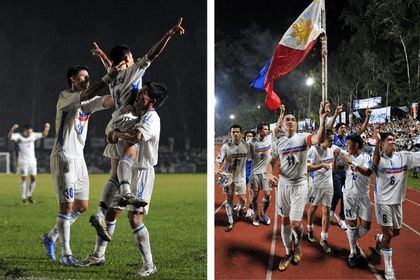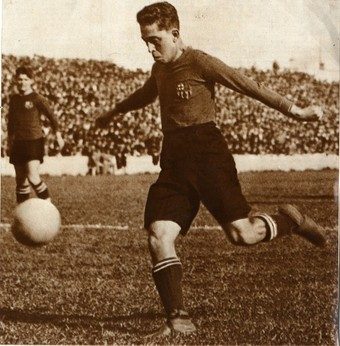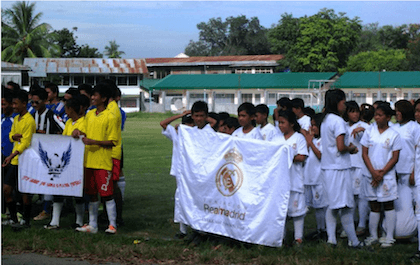SUMMARY
This is AI generated summarization, which may have errors. For context, always refer to the full article.

MANILA, Philippines – From being a nation obsessed with basketball but quite oblivious to other sports, it’s a wonder how football has suddenly inspired a manic craze among Filipinos.
Credit the Philippine Azkals for that. Their recent surge in popularity has been accompanied by sold-out games, numerous commercials, and a growing fan base.
Thanks to the recent performance of the national team, the Filipinos’ interest in football has increased, putting the spotlight even on lesser-known local clubs and football academies.
It’s football, not soccer
The beginnings of football in the country could be traced back to the time of the Spanish occupation. Spain has always had deep roots in football. No surprise therefore that they were the 2010 World Cup champions.
Our “national sport” basketball, on the other hand, was only introduced to the country by the Americans much later, with the 1950s as its peak years.
The Philippines is one of the oldest football countries in Asia, having its own football national team as far back as the 19th century.
Philippine Championships for football and Filipino players were even sent abroad to compete with world contenders.
Although many people call this sport “soccer,” that term has been introduced by the Americans so as not to confuse this game with American football.
‘The Netbreaker’
Back in 1896, a football champion was born to the Philippines. The story of Paulino Alcántara is of the stuff legends are made of. The son of a Spanish military officer and an Ilonggo mother, he was the first Asian to play for a European club.
Interestingly, Iloilo province has always had strong roots in football, home to greats such as current Azkals vice captain Chieffy Caligdong (once a Palarong Pambansa player) and forward Ian Araneta.

Alcántara is known for being one of the best players FC Barcelona has ever had. FC Barcelona, or Barça, is the premier football club of Barcelona, Catalonia, Spain. Today, it houses football superstars Lionel Messi and Xavi Hernandez.
What makes Alcántara memorable though would be his nickname “El Rompe Redes” or “The Netbreaker.” In a 1922 match against France, he kicked a 30-yarder with such force, he broke the net.
Although he was a player for Spain for most of his career, Alcántara came back to the Philippines for a while and helped the national team earn its highest win ever. The country scored 15-2 in a game against Japan. This result has not yet been beaten by the Azkals today.
However, Barça’s performance dwindled in his absence and he soon returned to play for Spain.
Ascending the ranks
After Alcántara’s time, the Philippines performance in world football rankings eventually dropped, giving way for the more American sports of baseball and basketball.
Ironically, 50 years after the historic match against Japan in 1917, the tables have turned. The lowest football game ever was also with Japan, where they scored 15 goals against the Philippines’ nil.
According to FIFA World Rankings, the lowest drop of the Philippine team would be during the months of Sept-Oct 2006, with a ranking of 195 out of 208.
However, the men’s team has risen relatively steadily from that time. Thanks to the recent string of football games of the Azkals, the Philippines is currently enjoying its highest FIFA ranking: 148.
On the other hand, the women’s team of the country had its lowest ranking in September 2011 at 133. Fortunately, they soon rose by 46 spots by December.

The women’s team has yet to enjoy the attention the Azkals are receiving, a trend not uncommon in the rest of the football world. After all, it is the male footballers who receive majority of the press focus.
The Azkals (the name of which is originally derived from the words Azul Calle or AzCal because of their blue kits) is under the Philippine Football Federation, currently headed by President Mariano Araneta, the country’s governing body. They are also members of the Asean Football Federation (AFF) and the Asian Football Confederation (AFC).
From zero to hero
What interests people, however, would be why football reached this popularity status only now. Perhaps one could trace it to the year 2010.
2010 saw an interesting change of events in the local football scene. Under the guidance of ex-coach Simon McMenemy, the Azkals won over Vietnam in group stage of the AFF Suzuki Cup, a game that has been named as one of the “Top 10 Soccer Stories” that year by Sports Illustrated.
One could also deduce that the global fanaticism caused by the 2010 World Cup has contributed to the increased media focus on football.
With the victory the Azkals achieved for the first time in the 2014 FIFA World Cup qualifiers against Sri Lanka, it sparked hope among the Filipinos that perhaps we could make it into the international stage, too.
However, the team did not make it past the qualifiers. The Azkals finished third place in the recent AFC Challenge cup though.
And yet another theory for the football fever would be the recruitment of ‘artista’-looking half-Pinoys by current coach Michael Weiss and the showbiz fame of the Younghusband brothers.
Although the Azkals has been home to multiracial Filipinos even before 2010, it was the increasing number of media organizations and advertisements that launched the team members to pop star-status.
News of Phil Younghusband’s involvement with actress Angel Locsin drew the rumor mill crazy for months and the sexual harassment scandals involving the team members constantly put the team on the national radar.
However, Philippine football is not simply about the national team and it is definitely not simply about showbiz.
A lot of stories need to be told, including those about the young rising stars of local football academies and the fans who grow increasingly devoted by the day.
And there are also many more heights to achieve, including launching the women’s team into fame, too, as well as strengthening local clubs to international status. – Rappler.com
Add a comment
How does this make you feel?
There are no comments yet. Add your comment to start the conversation.